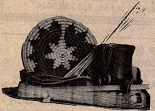|
Note:
The following information is being reproduced from the Navajo Times, without permission for educational purposes to teach the Navajo (Diné) language. |
||||||
|
Ti̜’ Diné Bizaad bee yádeilti’ dooleeł! Let’s go speak Navajo! |
||||||
|
Yá’át’ééh Marilyn Dempsey dashijní. Kiiyaa’áanii nishłí̜. Tó Dích’íi’nii báshíshchíín. Dibéłzhíní éí dashicheii. Hónágháahnii éí dashinálí. Kót’éego asdzá̜á̜ nishłí̜.

The Diné Bizaad page’s purpose is to provide an introduction to our indigenous language. Our language has been spoken by our people throughout time to communicate with one another, to sing, to pray, to express thoughts, and to think, plan, live, and reflect on our lives. Our great grandfather and leader, Chief Manuelito was quoted, “Shikéí, shidine’é, ałtah háási̜i̜łgóó… háadida léi’ nihizaad, nihisodizin, ádóone’é niidlínígíí dóó nihe’á’ál’í̜ nihił ch’aa wóle’ sha’áłchíní, hosídoolí̜i̜ji̜’, sidoołdee’ji̜’…” His words should not be forgotten and left by the wayside. So, it is up to each one of us to revitalize and maintain our dying language. Indigenous languages have been utilized in wars of the United States. Our Diné language was used to win a war for this country. Just as the Code Talkers used our language as a weapon, we too must use our language as a weapon to protect our Diné Culture and values. Diné Bizaad is one of the few indigenous languages left. We have not lost it all yet. Out of hundreds of indigenous languages pre-Columbus, there are less than 100 indigenous languages left that are spoken today. Language is essential to the survival of a culture. Language and culture is essential to one’s self-identity, self-esteem, foundation, and success in life. |
|
|||||
|
|
||||||